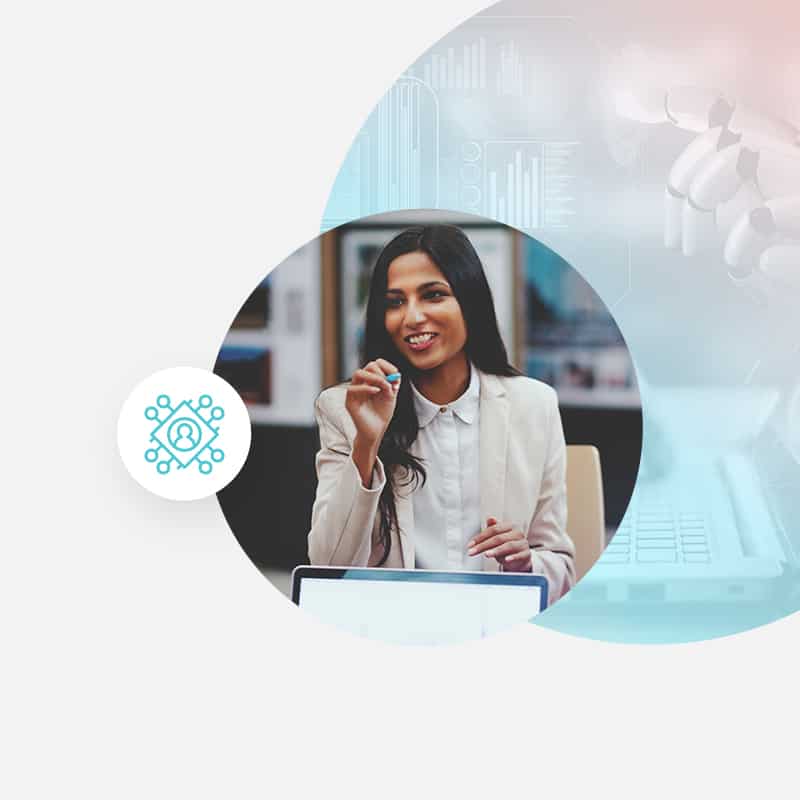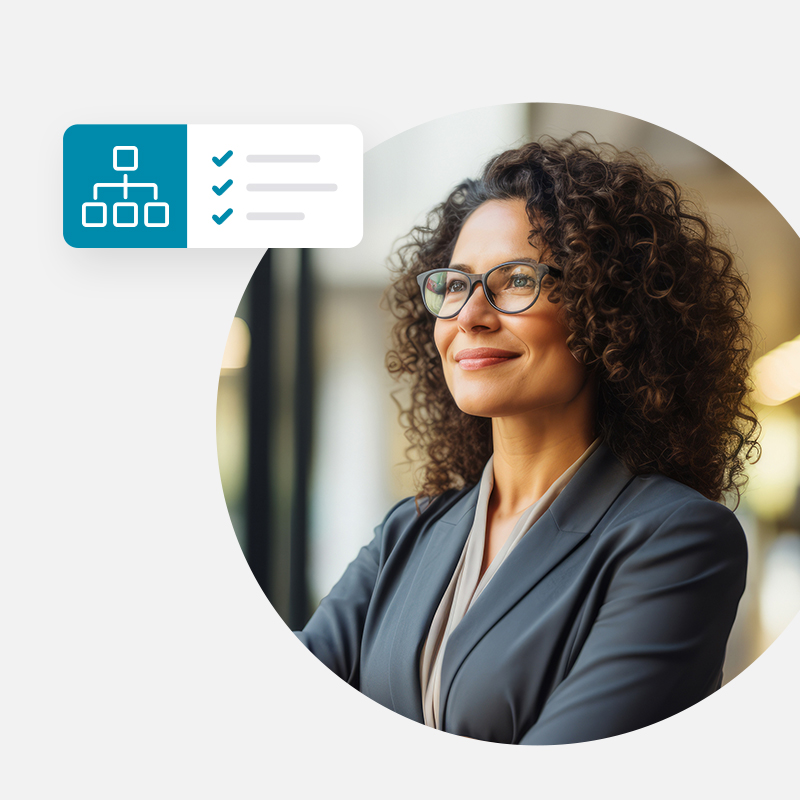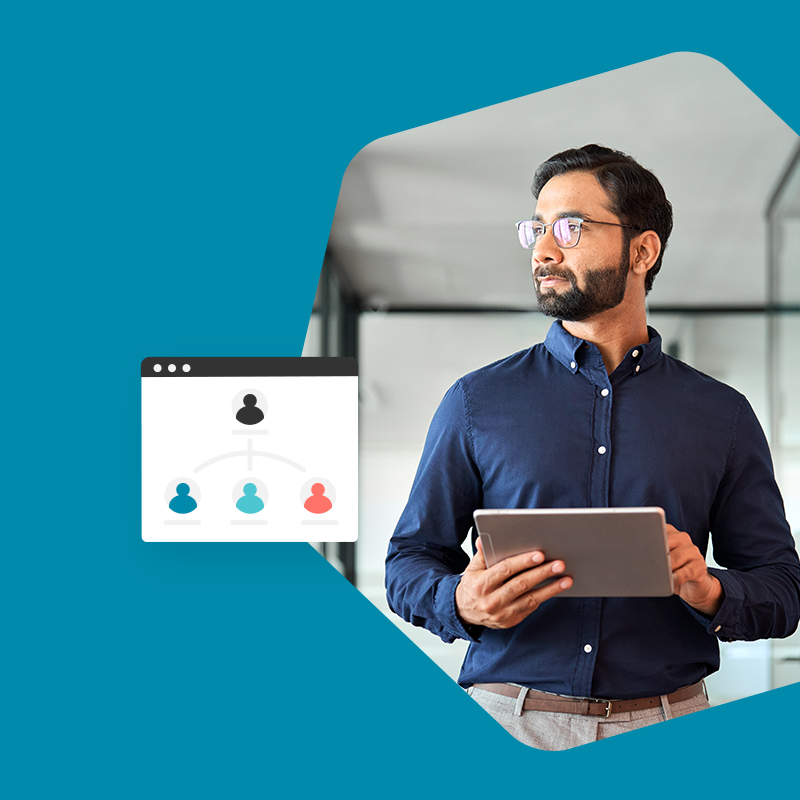- Use of artificial intelligence in HR is trending up
- 8 benefits of AI in HR
- Become a tactical and strategic asset
- Reduce human bias
- Improve relationships between employees
- Improve efficiency and insight in candidate assessment
- Supercharge strategic decision-making based on predictive data
- Prioritize your time and resources
- Automate repetitive tasks
- Remain open to new ideas and trends
- 5 use cases for applying artificial intelligence in the workforce
- The future of AI in people analytics
People analytics turns unrelated data points into insightful action plans that maximize your talent strategy. And when powered by AI, people analytics become even more powerful and predictive, helping HR leaders anticipate workforce challenges and capitalize on talent opportunities.
While many human resource leaders recognize the potential of people analytics and artificial intelligence, there remains a huge untapped opportunity. Research by Visier and the People Intelligence Alliance found that 3,000 North American companies have little or no people analytics capabilities. Those companies are squandering an average of $600 million in potential economic gain.
But capitalizing on people analytics requires more than just awareness. Learn more about why AI is increasingly important for HR, the benefits of AI in HR, and common use cases.
Use of artificial intelligence in HR is trending up
HR teams are increasingly using AI to streamline recruitment, onboarding, employee development and performance management. This isn’t new: Years before the pandemic, an IBM survey found that half of chief HR officers (CHROs) already recognized the technology’s potential to reinvent critical HR responsibilities.
What’s changed in the past few years, however, is HR’s ability to use sophisticated, reliable AI and automation tools at scale. Adoption is especially prevalent among larger companies, as 42% of firms with at least 5,000 workers reported using AI for HR tasks in early 2022. And while specialized roles like data analysts remain important for using AI effectively, user-friendly tools increasingly enable any employee to perform data analysis.
HR, machine learning, and AI are increasingly intertwined as work evolves. Nearly two-thirds of chief HR officers surveyed by The Conference Board see AI positively influencing their function over the next two years.
8 benefits of AI in HR
AI isn’t a replacement for HR teams. What AI does best is augment existing capabilities, by automating routine tasks and identifying insights that would otherwise be too time-consuming for a human alone to uncover. AI helps transform your HR with people analytics by adding predictive capabilities that drive data-driven decisions instead of relying on intuition or surface-level analysis. Here are eight ways AI helps HR departments.
Become a tactical and strategic asset
By providing actionable insights at scale, AI empowers HR teams to drive business results through a comprehensive talent strategy. For example, with predictive analytics, you can look at performance, learning and development, hiring, and internal mobility data to project whether you’ll have skills and people in place to hit goals five years out.
In an increasingly data-driven world, HR needs to be able to gather large amounts of data, analyze them quickly, and make sound decisions. AI helps HR leaders understand their workforce better and create strategies to increase engagement, productivity, and innovation.
Reduce human bias
Unconscious bias is part of being human and shapes decisions at every level of your organization. In theory, AI can reduce this effect because it can guide decisions based on massive amounts of data, rather than relying on individual preferences. It can also detect patterns that may point to bias in such activities as performance reviews, career development discussions, calibration, and promotions.
AI writing tools can also help HR, managers, and employees develop high-quality and consistent content that is unbiased, such as:
- Developing company policies or job descriptions
- Helping HR or people leaders prepare difficult conversations with employees
- Enabling employees to write thoughtful and appropriately phrased feedback
Down the line, ChatGPT could be the quintessential tool for organizational network analysis — analyzing in real-time every single conversation happening in the organization in email, Slack, Teams, and other applications — and connecting the dots to ensure all parties are on the same page, that no one is inadvertently left out, and alerting HR if someone does something that is inequitable.
However, the data that powers AI algorithms (not to mention the algorithms themselves) are rarely unbiased. And that can affect your use of predictive analytics. For example, when identifying high-potential employees, if your data only contains historical data on men getting such roles, the algorithm may be inadvertently trained to exclude women as future leaders.
You can also use AI to detect bias and alert HR, triggering follow-ups that mitigate the negative effects (and limit legal liability from discriminatory actions).
As long as you’re aware of AI’s limitations, you can apply it thoughtfully to reduce bias in HR processes.
Improve relationships between employees
AI can identify and analyze patterns in employee data to help HR leaders better understand employee behavior. This information can be used to create programs and policies that encourage positive employee relationships and improve productivity.
It may also be used to help employees provide thoughtful and properly stated feedback to peers when requested, such as through a performance management system.
Improve efficiency and insight in candidate assessment
Modern applicant tracking systems already use AI to help recruiters. AI is useful for screening resumes, cover letters, and candidate communication for indications of the person’s potential in the role they’re seeking.
AI tools collect data collected across the hiring process (from initial assessments to interview responses). They compare that data against industry benchmarks or historical data to project each candidate’s chance of success in a role. If a candidate submits a video interview or a personal resume website, for example, hiring managers can apply AI tools to the transcripts to glean insights that humans alone might have overlooked.
Supercharge strategic decision-making based on predictive data
People analytics, powered by AI, is a form of data-driven decision-making that focuses on uncovering meaningful insights from employee data to improve organizational performance, what Paul Rubenstein, the chief people officer at Visier, refers to as the “precursors to productivity.” You likely have a wealth of historical data in your organization that can help create AI-based models.
The best part about people analytics is that you aren’t limited to one analysis. You can change variables to project the various potential impacts of a decision. If the data shows that high performers are disengaging, for example, you can evaluate the impact of increasing promotions or learning opportunities on metrics such as engagement or turnover.
Using AI in people analytics also helps your managers to make better decisions about their work and how they can support their teams.
When managers have data-driven insights about their teams, they can think more strategically about improving performance, building skills, and mapping out career paths. Of course, AI is only a tool. Managers should also be having regular check-ins and goal conversations to keep employees informed and engaged.
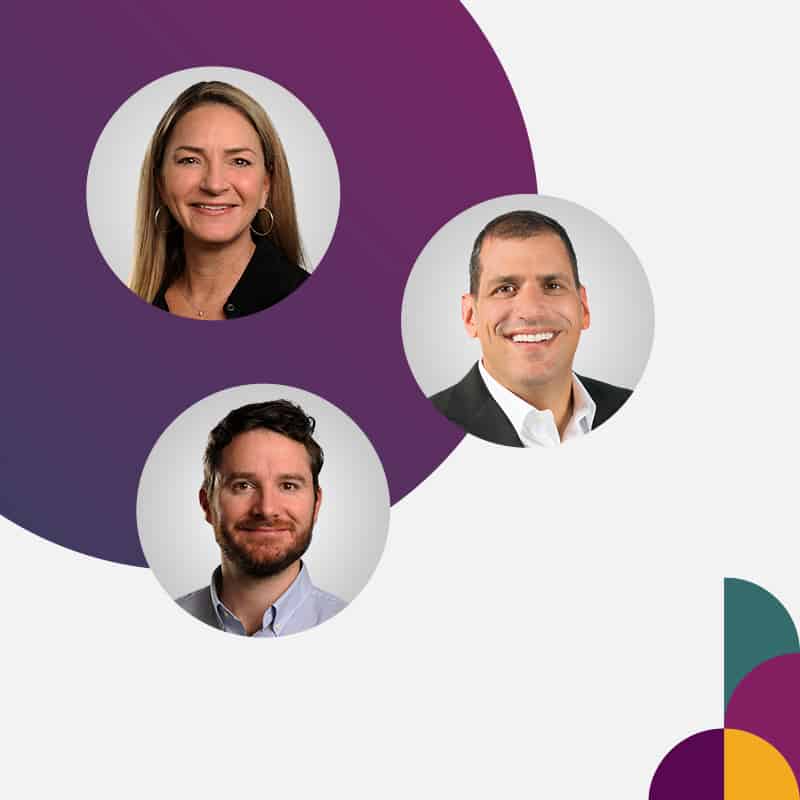
Prioritize your time and resources
HR is increasingly automating routine and repetitive tasks. This was happening even before the latest wave of AI, and AI use cases are only increasing.
AI-driven people analytics solutions, for example, make it easy to slice and dice workforce performance in a few clicks, providing insights that would have otherwise taken hours to generate.. Now, you can jump right into solutions — saving time and increasing your impact on the business. For example, Betterworks’ partnership with Visier will enable data visualizations that will make it easier for HR and others in the organization to understand the data AI generates.
Automate repetitive tasks
ChatGPT and other large language models can help HR practitioners, managers, and employees save time by automating repetitive tasks, and help create consistently high-quality content, such as:
- Helping HR create company policies or job descriptions
- Assisting employees with defining good goals and milestones that are aligned with company strategy and with their career ambitions
Remain open to new ideas and trends
There’s a reason tools like ChatGPT and other large language models have gained traction so quickly. Business leaders recognize how AI can save time and reduce costs in many areas without sacrificing quality. While HR professionals should view AI tools critically, don’t ignore this trend. Look at how AI and other technologies can improve HR’s impact and efficiency. Push back on use cases that don’t make sense, as well as legal and ethical violations. But don’t fight AI itself.
ChatGPT’s explosive growth highlights another trend in AI: the democratization of AI capabilities. Today, in-house developers can build proprietary algorithms without particular training or expertise. This opens up new and exciting possibilities for people analytics.
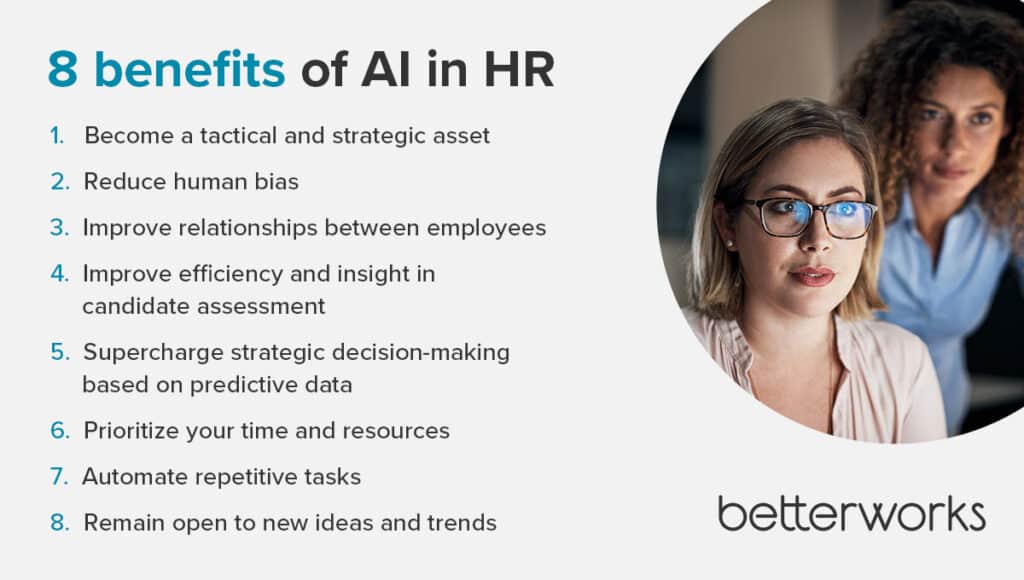
5 use cases for applying artificial intelligence in the workforce
Here are five specific use cases for using AI to build a better workforce.
Sentiment analysis
Feedback is a combination of the quantitative and qualitative. AI-based text analysis systems can help you interpret and understand worker sentiments by categorizing feedback as positive, neutral, or negative. This framework provides a window into how your workforce feels on a day-to-day basis.
While sentiment analysis isn’t new, AI is turbocharging this approach. By combining survey data with other information, such as historical data and industry trends, AI unlocks predictive insights into workforce engagement, risk of turnover, and more.
AI-enabled sentiment analysis works well with many existing HR activities. The annual employee engagement survey can move from a static snapshot of worker sentiment into a vital, real-time analysis of the social framework that supports the entire organization.
Feedback response
Organizing and dividing feedback into insightful slices is incredibly time-consuming. Machine learning in HR can automatically categorize feedback data into predefined HR categories such as work-life integration, compensation and benefits, or employee experience. With this data sorted, HR has an easier time examining the findings and acting on them
You can also measure employee satisfaction by using AI to analyze natural language in communication across the business to quantify a speaker’s underlying emotions, not just the message itself. Such technologies also show promise for analyzing conversations across the organization, including in email and chat tools.
Instead of addressing negative events (e.g., a disgruntled employee, bad behavior) reactively, AI-powered text analysis could flag potential issues while there’s still time to address them.
Smart assistants
AI-based assistance can drive relevant and contextual alerts to managers based on conversations occurring within an organization. An AI-driven workflow tool, for example, could alert managers when an employee has leveled up their skills and is ready for new career opportunities within the organization.
AI as a smart assistant helps HR see opportunities to improve the organization in real time. Instead of HR pulling reports manually, AI can push important information to HR.
Talent selection
Smart AI mechanisms can scan, read, and evaluate job applicants against the criteria you set for each role. Using AI to identify the top candidates reduces the time spent whittling down the candidate slate and remains more objective than human recruiters. Using AI in this capacity can drastically increase the quality of hiring decisions and provide a huge timesaver for recruiting and HR teams.
Chatbot interactions
AI-powered chatbots can create streamlined and unique employee experiences based on personal interaction with every employee and historical data. While onboarding, for example, remains a deeply personal experience, chatbots can easily and accurately answer standard new-hire questions at any time, not just when a manager or other co-worker is available.
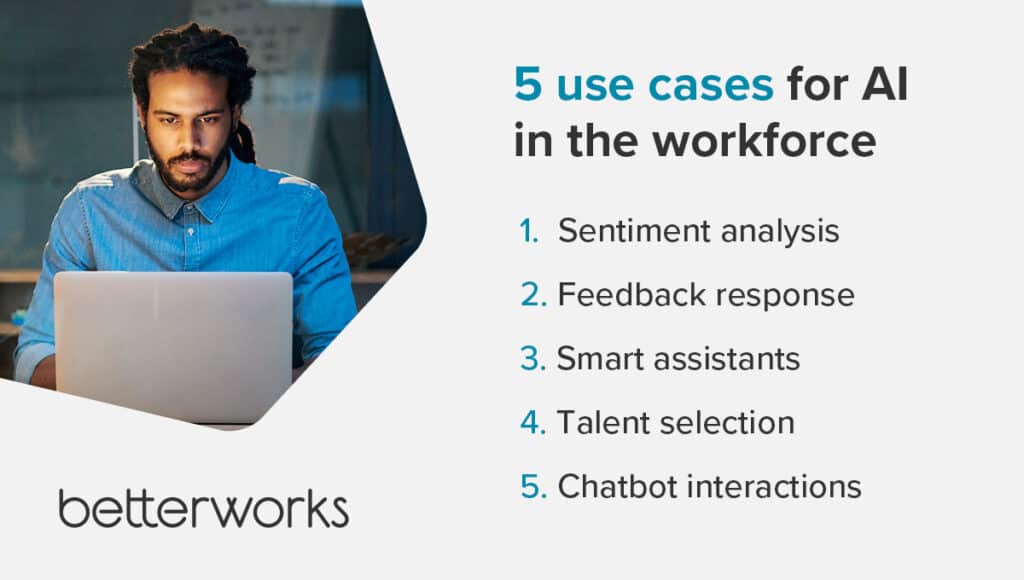
The future of AI in people analytics
Organizations are increasingly focused on how people analytics will take HR to the next level. AI is part of that sea change, and we’re still in the early days. AI will only become more powerful, more focused, and more relevant for HR leaders who are building world-class organizations.
AI in people analytics will help HR act in real-time with evidence-based decisions. Executives will be able to forecast their workforce needs more accurately. Managers will have better guidance for driving performance enablement within their teams, and employees will feel heard, seen, and supported by their organizations.
This transformation of HR and AI will require curiosity, experimentation, and close attention to legal and ethical pitfalls. HR leaders will need to guide organizations on the most effective uses of AI while addressing concerns about privacy, security, and compliance. But the potential is clear: AI will help HR gain visibility into the true state of the workforce and make data-driven decisions that build a stronger future for workers and the business.
Learn more about best practices for implementing people analytics.
12 Ideas for Strengthening Your People Analytcis
